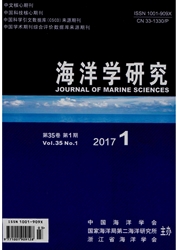

 中文摘要:
中文摘要:
依托中国“大洋一号”第20和第21调查航次,分析测定了东、西赤道太平洋4个站位的颗粒态生物硅浓度及其粒级结构.结果显示赤道太平洋采样站各层位颗粒态生物硅(PBSi)总浓度分布范围为5~65 nmol/dm3,东赤道太平洋的调查站位颗粒态生物硅的总浓度平均值达46 nmol/dm3,是西赤道太平洋的近3倍.PBSi的粒径结果显示在东赤道太平洋调查站位0.8~20μm粒径颗粒是PBSi的主要来源,其平均贡献率高达64%;而在西赤道太平洋2种粒径的生物硅贡献率相当.营养盐分布对PBSi的浓度及粒径分布有显著的影响,并在一定程度上控制了“硅质泵”的组成结构,是控制大洋生物泵运转的重要因素.
 英文摘要:
英文摘要:
During the Chinese DY20 and DY21 cruises, size-fractionated particulate biogenic silica (PBSi) and nutrients were analyzed for samples at 4 stations in the eastern and western Equatorial Pacific. It showed that the total PBSi concentrations at 4 stations were at a range of 5~65 nmol/ dma and its mean value in the eastern Equatorial Pacific was 46 nmol/dma, which was about 3 times higher than that in the western Equatorial Pacific. PBSi concentrations with the size of 0.8~20 μm accounted for the major contributor of the total PBSi concentrations in the eastern Equatorial Pacific with an average contribution of 64%, while the contributions of two size classes of PBSi concentrations were equal in the western Equatorial Pacific. The results were that the distribution of nutrients had a prominent impact on the concentration and size composition of biogenic silica. And it might be an important factor in controlling the efficiency of biological pump in the Equatorial Ocean by controlling the composition structure of "silica pump".
 同期刊论文项目
同期刊论文项目
 同项目期刊论文
同项目期刊论文
 Estimation of typhoon-enhanced primary production in the South China Sea: A comparison with the West
Estimation of typhoon-enhanced primary production in the South China Sea: A comparison with the West Out-of-phase relationshipbetween tropical cyclones generated locally in the South China Sea andnon-l
Out-of-phase relationshipbetween tropical cyclones generated locally in the South China Sea andnon-l 期刊信息
期刊信息
